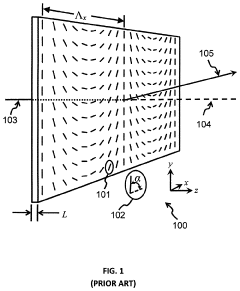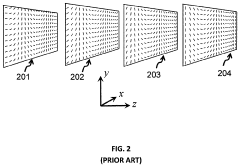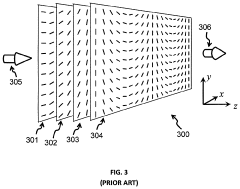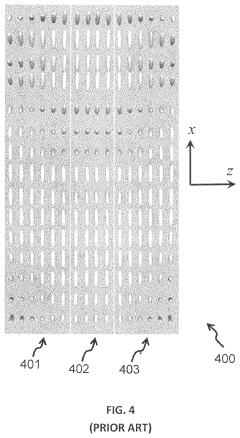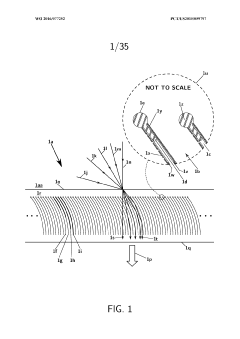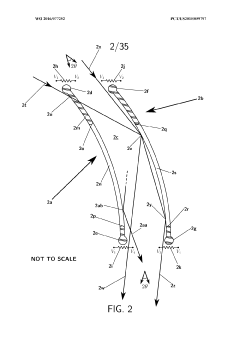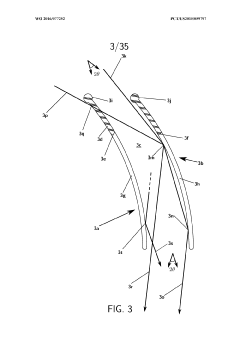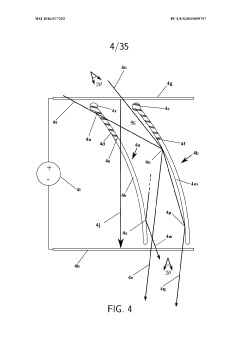Achieving Wide-Angle Beam Steering With Minimal Efficiency Loss
SEP 1, 20259 MIN READ
Generate Your Research Report Instantly with AI Agent
Patsnap Eureka helps you evaluate technical feasibility & market potential.
Beam Steering Technology Evolution and Objectives
Beam steering technology has evolved significantly over the past several decades, transitioning from mechanical systems to sophisticated electronic and optical solutions. Initially, beam steering relied primarily on physically rotating antennas or reflectors, which limited speed and precision while introducing reliability concerns due to moving parts. The 1960s marked a pivotal shift with the introduction of phased array technology, enabling electronic beam steering through phase manipulation across multiple radiating elements without mechanical movement.
The 1990s witnessed accelerated development in semiconductor-based phase shifters and digital beamforming techniques, dramatically improving steering capabilities. With the advent of 5G communications and advanced radar systems in the 2000s, millimeter-wave beam steering became increasingly important, driving innovations in materials and fabrication processes to support higher frequencies.
Recent years have seen remarkable progress in optical beam steering technologies, including optical phased arrays, metasurfaces, and liquid crystal-based solutions. These approaches offer potential advantages in bandwidth, power consumption, and form factor compared to traditional electronic methods. Particularly noteworthy is the emergence of metasurface technology, which enables manipulation of electromagnetic waves at subwavelength scales through engineered nanostructures.
Despite these advances, achieving wide-angle beam steering while maintaining high efficiency remains a significant technical challenge. Conventional phased arrays typically experience substantial efficiency degradation at large steering angles, often following a cosine relationship that results in significant power loss beyond ±45 degrees. This limitation stems from factors including element pattern roll-off, mutual coupling effects, and phase quantization errors.
The primary objective in this technical domain is to develop beam steering solutions capable of maintaining high efficiency (>80%) across wide angular ranges (±70 degrees or greater) while simultaneously addressing constraints related to size, weight, power consumption, and cost. This goal is particularly critical for emerging applications in autonomous vehicles, satellite communications, and next-generation wireless networks where wide coverage and efficient power utilization are essential.
Secondary objectives include reducing system complexity, improving manufacturing scalability, enhancing operational bandwidth, and ensuring compatibility with existing infrastructure. The ideal solution would provide continuous, high-resolution steering across the entire field of view without compromising on performance metrics or introducing prohibitive implementation challenges.
The 1990s witnessed accelerated development in semiconductor-based phase shifters and digital beamforming techniques, dramatically improving steering capabilities. With the advent of 5G communications and advanced radar systems in the 2000s, millimeter-wave beam steering became increasingly important, driving innovations in materials and fabrication processes to support higher frequencies.
Recent years have seen remarkable progress in optical beam steering technologies, including optical phased arrays, metasurfaces, and liquid crystal-based solutions. These approaches offer potential advantages in bandwidth, power consumption, and form factor compared to traditional electronic methods. Particularly noteworthy is the emergence of metasurface technology, which enables manipulation of electromagnetic waves at subwavelength scales through engineered nanostructures.
Despite these advances, achieving wide-angle beam steering while maintaining high efficiency remains a significant technical challenge. Conventional phased arrays typically experience substantial efficiency degradation at large steering angles, often following a cosine relationship that results in significant power loss beyond ±45 degrees. This limitation stems from factors including element pattern roll-off, mutual coupling effects, and phase quantization errors.
The primary objective in this technical domain is to develop beam steering solutions capable of maintaining high efficiency (>80%) across wide angular ranges (±70 degrees or greater) while simultaneously addressing constraints related to size, weight, power consumption, and cost. This goal is particularly critical for emerging applications in autonomous vehicles, satellite communications, and next-generation wireless networks where wide coverage and efficient power utilization are essential.
Secondary objectives include reducing system complexity, improving manufacturing scalability, enhancing operational bandwidth, and ensuring compatibility with existing infrastructure. The ideal solution would provide continuous, high-resolution steering across the entire field of view without compromising on performance metrics or introducing prohibitive implementation challenges.
Market Applications and Demand Analysis for Wide-Angle Beam Steering
Wide-angle beam steering technology has witnessed exponential market growth across multiple sectors due to its ability to direct electromagnetic waves over broader angular ranges with minimal efficiency degradation. The global market for beam steering systems is projected to reach $7.4 billion by 2026, growing at a CAGR of 22.9% from 2021, primarily driven by applications requiring precise directional control of electromagnetic radiation.
The automotive industry represents one of the largest market segments, with LiDAR-based advanced driver assistance systems (ADAS) and autonomous vehicles requiring wide-angle beam steering capabilities. This sector alone accounts for approximately 35% of the total market share, with major automotive manufacturers investing heavily in this technology to enhance sensing capabilities and improve safety features.
Telecommunications, particularly with the global rollout of 5G and future 6G networks, presents another significant market opportunity. Wide-angle beam steering enables dynamic beam forming in phased array antennas, allowing for improved coverage, reduced interference, and enhanced data throughput. The telecom sector's demand is expected to grow by 27% annually through 2025 as network densification continues worldwide.
Defense and aerospace applications constitute a premium segment of the market, valuing efficiency over cost considerations. Military radar systems, satellite communications, and electronic warfare systems all benefit from wide-angle beam steering technologies that maintain high efficiency across the steering range. This sector represents approximately 28% of the current market value but commands higher profit margins due to specialized requirements.
Consumer electronics manufacturers are increasingly incorporating beam steering technology in emerging products. Augmented reality (AR) and virtual reality (VR) devices utilize optical beam steering for improved display capabilities and user interaction, while smart home systems employ RF beam steering for enhanced connectivity. This segment is growing at 31% annually, the fastest among all application areas.
Medical imaging and treatment systems represent a smaller but high-value market segment. Focused ultrasound therapy, optical coherence tomography, and advanced imaging systems all benefit from precise beam steering capabilities with minimal energy loss, improving diagnostic accuracy and treatment efficacy while reducing patient exposure to radiation or other energies.
Market analysis indicates that customers across all segments prioritize three key factors: steering range, efficiency maintenance across the steering range, and system compactness. Solutions that can achieve wide-angle steering (>±60°) while maintaining over 90% efficiency throughout the range command premium pricing, with customers willing to pay 40-60% more compared to conventional limited-angle systems.
The automotive industry represents one of the largest market segments, with LiDAR-based advanced driver assistance systems (ADAS) and autonomous vehicles requiring wide-angle beam steering capabilities. This sector alone accounts for approximately 35% of the total market share, with major automotive manufacturers investing heavily in this technology to enhance sensing capabilities and improve safety features.
Telecommunications, particularly with the global rollout of 5G and future 6G networks, presents another significant market opportunity. Wide-angle beam steering enables dynamic beam forming in phased array antennas, allowing for improved coverage, reduced interference, and enhanced data throughput. The telecom sector's demand is expected to grow by 27% annually through 2025 as network densification continues worldwide.
Defense and aerospace applications constitute a premium segment of the market, valuing efficiency over cost considerations. Military radar systems, satellite communications, and electronic warfare systems all benefit from wide-angle beam steering technologies that maintain high efficiency across the steering range. This sector represents approximately 28% of the current market value but commands higher profit margins due to specialized requirements.
Consumer electronics manufacturers are increasingly incorporating beam steering technology in emerging products. Augmented reality (AR) and virtual reality (VR) devices utilize optical beam steering for improved display capabilities and user interaction, while smart home systems employ RF beam steering for enhanced connectivity. This segment is growing at 31% annually, the fastest among all application areas.
Medical imaging and treatment systems represent a smaller but high-value market segment. Focused ultrasound therapy, optical coherence tomography, and advanced imaging systems all benefit from precise beam steering capabilities with minimal energy loss, improving diagnostic accuracy and treatment efficacy while reducing patient exposure to radiation or other energies.
Market analysis indicates that customers across all segments prioritize three key factors: steering range, efficiency maintenance across the steering range, and system compactness. Solutions that can achieve wide-angle steering (>±60°) while maintaining over 90% efficiency throughout the range command premium pricing, with customers willing to pay 40-60% more compared to conventional limited-angle systems.
Current Limitations and Technical Challenges in Beam Steering Efficiency
Despite significant advancements in beam steering technology, several critical limitations continue to challenge the achievement of wide-angle beam steering with minimal efficiency loss. Traditional phased array systems face fundamental physical constraints when steering beams at large angles, resulting in what is known as "scan loss." This efficiency degradation follows a cosine relationship with the steering angle, causing significant power reduction at wide angles—potentially losing up to 50% efficiency at 60-degree steering angles.
Material limitations present another significant challenge. Current phase shifter technologies, whether based on liquid crystals, MEMS, or semiconductor approaches, exhibit varying degrees of insertion loss that compound with increasing steering angles. These losses are particularly problematic in applications requiring high signal integrity, such as automotive radar and satellite communications.
Fabrication precision requirements escalate dramatically for wide-angle beam steering systems. Even minor manufacturing variations in antenna element spacing or phase shifter performance can cause substantial beam pointing errors and sidelobe degradation at wide angles. This challenge becomes particularly acute in millimeter-wave and terahertz applications where wavelengths are extremely small.
Power handling capabilities represent another critical constraint. As systems attempt to compensate for efficiency losses at wide angles by increasing input power, thermal management becomes increasingly difficult. This creates a complex engineering trade-off between steering range, efficiency, and system reliability.
Bandwidth limitations further complicate wide-angle beam steering. Most current solutions exhibit frequency-dependent behavior, with performance degrading significantly at the edges of their operational bandwidth. This creates challenges for wideband applications like advanced sensing and communications systems.
The computational complexity of controlling wide-angle beam steering systems presents additional hurdles. Real-time calibration and compensation algorithms needed to maintain efficiency across steering angles require substantial processing resources, increasing system cost and power consumption.
Integration challenges also persist, particularly for compact applications. The need for sophisticated cooling systems, complex control electronics, and precise mechanical alignment makes it difficult to incorporate efficient wide-angle beam steering into space-constrained platforms like smartphones or wearable devices.
Finally, there exists a fundamental trade-off between steering range and aperture efficiency that has not been fully resolved by current technologies. This represents perhaps the most significant challenge in the field, requiring innovative approaches that transcend conventional phased array architectures.
Material limitations present another significant challenge. Current phase shifter technologies, whether based on liquid crystals, MEMS, or semiconductor approaches, exhibit varying degrees of insertion loss that compound with increasing steering angles. These losses are particularly problematic in applications requiring high signal integrity, such as automotive radar and satellite communications.
Fabrication precision requirements escalate dramatically for wide-angle beam steering systems. Even minor manufacturing variations in antenna element spacing or phase shifter performance can cause substantial beam pointing errors and sidelobe degradation at wide angles. This challenge becomes particularly acute in millimeter-wave and terahertz applications where wavelengths are extremely small.
Power handling capabilities represent another critical constraint. As systems attempt to compensate for efficiency losses at wide angles by increasing input power, thermal management becomes increasingly difficult. This creates a complex engineering trade-off between steering range, efficiency, and system reliability.
Bandwidth limitations further complicate wide-angle beam steering. Most current solutions exhibit frequency-dependent behavior, with performance degrading significantly at the edges of their operational bandwidth. This creates challenges for wideband applications like advanced sensing and communications systems.
The computational complexity of controlling wide-angle beam steering systems presents additional hurdles. Real-time calibration and compensation algorithms needed to maintain efficiency across steering angles require substantial processing resources, increasing system cost and power consumption.
Integration challenges also persist, particularly for compact applications. The need for sophisticated cooling systems, complex control electronics, and precise mechanical alignment makes it difficult to incorporate efficient wide-angle beam steering into space-constrained platforms like smartphones or wearable devices.
Finally, there exists a fundamental trade-off between steering range and aperture efficiency that has not been fully resolved by current technologies. This represents perhaps the most significant challenge in the field, requiring innovative approaches that transcend conventional phased array architectures.
State-of-the-Art Wide-Angle Beam Steering Solutions
01 Wide-angle beam steering technologies
Various technologies enable wide-angle beam steering capabilities in optical and electromagnetic systems. These include advanced optical components, phased arrays, and specialized lenses that can direct beams across large angular ranges. Wide-angle beam steering is crucial for applications requiring broad spatial coverage such as radar systems, LiDAR, and optical communications. These technologies typically employ innovative mechanisms to overcome traditional limitations in steering range.- Optical phased array technology for wide-angle beam steering: Optical phased arrays (OPAs) enable wide-angle beam steering by controlling the phase of light across an array of optical elements. These systems can achieve large steering angles without mechanical components, making them suitable for applications requiring rapid and precise beam control. The technology typically uses phase shifters or optical modulators to create constructive interference in the desired direction. Advanced OPA designs can achieve wide steering ranges while maintaining beam quality.
- Efficiency loss mitigation in beam steering systems: Various techniques are employed to mitigate efficiency losses in beam steering systems. These include optimizing the design of optical components, using high-efficiency materials, and implementing advanced control algorithms. Some approaches focus on reducing insertion losses in phase shifters, minimizing diffraction losses, and improving power distribution across the steering elements. Compensation mechanisms can also be implemented to maintain performance across wide steering angles where efficiency typically degrades.
- MEMS-based beam steering solutions: Micro-Electro-Mechanical Systems (MEMS) provide an effective approach for wide-angle beam steering with reduced efficiency losses. These systems use tiny movable mirrors or structures that can be precisely controlled to redirect light. MEMS-based solutions offer advantages including fast response times, compact size, and the ability to maintain beam quality across steering angles. Advanced MEMS designs incorporate multiple degrees of freedom to achieve wider steering ranges while minimizing power consumption and optical losses.
- Liquid crystal-based beam steering technology: Liquid crystal (LC) materials are utilized in beam steering applications to achieve wide-angle capabilities. These systems manipulate the orientation of LC molecules to control the refractive index and thereby steer light beams. LC-based steering can provide continuous angle control without mechanical parts, though they typically face challenges with response speed and efficiency at extreme angles. Advanced designs incorporate multi-layer structures, optimized electrode patterns, and specialized LC materials to improve steering range while maintaining acceptable efficiency levels.
- Hybrid and novel beam steering approaches: Hybrid approaches combine multiple beam steering technologies to overcome the limitations of individual methods. These systems might integrate mechanical and non-mechanical elements, or combine different non-mechanical technologies such as acousto-optic and electro-optic components. Novel approaches include metamaterial-based steering, programmable diffractive elements, and photonic integrated circuits. These hybrid and innovative solutions aim to achieve wider steering angles while minimizing the efficiency losses that typically occur at extreme angles, providing better performance for demanding applications.
02 Efficiency loss mitigation in beam steering systems
Beam steering systems often experience efficiency losses, particularly at extreme steering angles. Various approaches address this challenge, including optimized optical designs, adaptive compensation techniques, and novel materials. Methods to mitigate efficiency losses include energy recovery mechanisms, improved coupling designs, and specialized coatings that reduce absorption and scattering. These solutions aim to maintain signal strength and system performance across the entire steering range.Expand Specific Solutions03 Phased array beam steering technology
Phased array technology enables beam steering by controlling the phase of individual elements in an array. This approach allows for electronic steering without mechanical movement, offering advantages in speed and reliability. Phased arrays can be implemented in various domains including radio frequency, optical, and acoustic systems. Advanced phased array designs incorporate techniques to expand steering angles while minimizing side lobes and interference effects.Expand Specific Solutions04 MEMS-based beam steering solutions
Micro-Electro-Mechanical Systems (MEMS) provide compact and efficient beam steering capabilities. These systems utilize tiny movable mirrors or other microstructures to redirect light or electromagnetic waves. MEMS-based solutions offer advantages in size, power consumption, and cost compared to traditional approaches. They can achieve wide steering angles through various actuation mechanisms while addressing challenges related to response time and precision control.Expand Specific Solutions05 Optical beam steering innovations
Advanced optical beam steering innovations employ novel materials and designs to achieve enhanced performance. These include liquid crystal spatial light modulators, tunable metamaterials, and holographic elements. Such technologies enable precise control of light propagation while addressing traditional limitations in steering range and efficiency. Innovations in this area focus on achieving wider steering angles, faster response times, and reduced power consumption for applications in communications, sensing, and display technologies.Expand Specific Solutions
Leading Companies and Research Institutions in Beam Steering Technology
The wide-angle beam steering technology market is currently in a growth phase, with increasing demand across defense, telecommunications, and automotive sectors. The market is projected to expand significantly due to applications in radar systems, satellite communications, and autonomous vehicles. Technologically, companies are at varying maturity levels. Defense contractors like Raytheon, BAE Systems, and Northrop Grumman lead with advanced phased array technologies, while telecommunications giants Huawei, ZTE, and Samsung are developing innovative beam steering solutions for 5G/6G networks. Research-focused entities like LeddarTech and Boulder Nonlinear Systems are pioneering liquid crystal and MEMS-based approaches. Academic institutions including Duke University and Keio University contribute fundamental research, creating a competitive landscape where collaboration between industry and academia drives innovation toward achieving efficient wide-angle beam steering capabilities.
Huawei Technologies Co., Ltd.
Technical Solution: Huawei has developed an innovative beam steering solution utilizing their proprietary Massive MIMO architecture combined with advanced algorithm optimization. Their technology employs a hybrid beamforming approach that combines analog and digital beamforming to achieve wide-angle coverage while maintaining high efficiency. Huawei's system incorporates machine learning algorithms that continuously optimize element excitation patterns based on real-time performance metrics, compensating for efficiency losses at extreme angles. Their solution features custom-designed RF front-end modules with adaptive impedance matching networks that dynamically adjust to maintain optimal power transfer across wide steering angles. Huawei has implemented sophisticated calibration techniques that account for manufacturing variations and environmental factors, ensuring consistent performance across the entire steering range. Their beam steering technology also incorporates advanced thermal management solutions specifically designed to address hotspots that develop during wide-angle operations.
Strengths: Excellent integration with 5G infrastructure, superior algorithm optimization capabilities, and cost-effective implementation. Weaknesses: Less proven in military/aerospace applications, potential security concerns in certain markets, and higher computational requirements.
The Boeing Co.
Technical Solution: Boeing has pioneered conformal phased array technology that enables wide-angle beam steering while maintaining high efficiency across the scanning range. Their approach utilizes curved array geometries that naturally compensate for cosine loss effects typically experienced at wide steering angles. Boeing's beam steering technology incorporates advanced metamaterial-based wide-angle impedance matching layers that significantly reduce reflection losses at the air-antenna interface across broad steering angles. The company has developed proprietary GaN-based amplifier modules with adaptive biasing schemes that dynamically adjust power delivery based on steering angle to maintain optimal efficiency. Boeing's systems employ sophisticated calibration techniques that account for mutual coupling effects between array elements, which become particularly problematic at extreme steering angles. Their technology also features integrated thermal management solutions specifically designed to address hotspots that develop during wide-angle operations.
Strengths: Exceptional performance in aerospace applications, proven reliability in extreme environments, and superior system integration capabilities. Weaknesses: High implementation costs, complex manufacturing requirements, and significant size/weight considerations for certain applications.
Critical Patents and Innovations in Efficiency Preservation
High-efficiency wide-angle beam steering system
PatentActiveUS11366254B2
Innovation
- The use of twist-uniform-twist (TUT) cycloidal diffractive waveplates and polarization volume gratings in beam steering systems, where the optical anisotropy axis orientation varies along multiple Cartesian coordinates, and the incorporation of polarization converters to optimize diffraction efficiency at steep angles and across a broad wavelength range.
Wide-angle, broad-band, polarization independent beam steering and concentration of wave energy utilizing electronically controlled soft matter
PatentWO2016077252A1
Innovation
- The use of electronically controlled soft matter structures, such as Liquid Phase Beam Steering (LPBS), Solid Phase Beam Steering (SPBS), Gas Phase Beam Steering (GPBS), and Plasma Phase Beam Steering (PPBS) devices, which manipulate index matching fluids or gases within microfluidic control channels to steer and focus waves through total internal reflection, diffraction, or refraction, enabling continuous angular control and polarization independence.
Materials Science Advancements for Beam Steering Applications
Recent advancements in materials science have significantly contributed to overcoming the challenges associated with wide-angle beam steering efficiency. Traditional beam steering technologies often suffer from substantial efficiency losses when operating at wider angles, primarily due to limitations in the physical properties of conventional materials. The emergence of metamaterials and metasurfaces has revolutionized this field by enabling unprecedented control over electromagnetic wave propagation.
Engineered metamaterials with negative refractive indices have demonstrated the ability to manipulate electromagnetic waves in ways previously thought impossible. These materials consist of sub-wavelength structures that can be precisely designed to achieve specific electromagnetic responses. For beam steering applications, metamaterials with gradient refractive index profiles have shown particular promise, allowing for smooth transitions in wave propagation direction without the abrupt interfaces that typically cause reflection losses.
Phase-change materials (PCMs) represent another breakthrough category, offering dynamic control over material properties through external stimuli. Materials such as germanium-antimony-tellurium (GST) compounds can rapidly switch between amorphous and crystalline states, each with distinct optical properties. This switchability enables active beam steering systems that can adapt to changing requirements without mechanical movement, significantly reducing efficiency losses associated with traditional mechanical steering mechanisms.
Two-dimensional materials, including graphene and transition metal dichalcogenides (TMDCs), have emerged as excellent candidates for beam steering applications due to their exceptional electrical and optical properties. Graphene, in particular, exhibits tunable conductivity under applied voltage, allowing for electrically controlled phase shifts in electromagnetic waves. When integrated into phased array systems, these materials enable wide-angle beam steering with minimal efficiency degradation across the steering range.
Liquid crystals have been reimagined for beam steering applications through novel molecular engineering approaches. By developing liquid crystal compositions with enhanced birefringence and faster switching speeds, researchers have created non-mechanical beam steering devices capable of maintaining high efficiency across wide angular ranges. These materials benefit from established manufacturing processes, making them particularly attractive for commercial applications.
Transparent conducting oxides (TCOs) such as indium tin oxide (ITO) and aluminum-doped zinc oxide (AZO) have been engineered to exhibit tunable epsilon-near-zero (ENZ) behavior, where the real part of permittivity approaches zero at specific wavelengths. This unique property enables extraordinary beam steering capabilities with minimal reflection losses, even at extreme angles. Recent developments in atomic layer deposition techniques have further improved the quality and performance of these materials in optical beam steering applications.
Engineered metamaterials with negative refractive indices have demonstrated the ability to manipulate electromagnetic waves in ways previously thought impossible. These materials consist of sub-wavelength structures that can be precisely designed to achieve specific electromagnetic responses. For beam steering applications, metamaterials with gradient refractive index profiles have shown particular promise, allowing for smooth transitions in wave propagation direction without the abrupt interfaces that typically cause reflection losses.
Phase-change materials (PCMs) represent another breakthrough category, offering dynamic control over material properties through external stimuli. Materials such as germanium-antimony-tellurium (GST) compounds can rapidly switch between amorphous and crystalline states, each with distinct optical properties. This switchability enables active beam steering systems that can adapt to changing requirements without mechanical movement, significantly reducing efficiency losses associated with traditional mechanical steering mechanisms.
Two-dimensional materials, including graphene and transition metal dichalcogenides (TMDCs), have emerged as excellent candidates for beam steering applications due to their exceptional electrical and optical properties. Graphene, in particular, exhibits tunable conductivity under applied voltage, allowing for electrically controlled phase shifts in electromagnetic waves. When integrated into phased array systems, these materials enable wide-angle beam steering with minimal efficiency degradation across the steering range.
Liquid crystals have been reimagined for beam steering applications through novel molecular engineering approaches. By developing liquid crystal compositions with enhanced birefringence and faster switching speeds, researchers have created non-mechanical beam steering devices capable of maintaining high efficiency across wide angular ranges. These materials benefit from established manufacturing processes, making them particularly attractive for commercial applications.
Transparent conducting oxides (TCOs) such as indium tin oxide (ITO) and aluminum-doped zinc oxide (AZO) have been engineered to exhibit tunable epsilon-near-zero (ENZ) behavior, where the real part of permittivity approaches zero at specific wavelengths. This unique property enables extraordinary beam steering capabilities with minimal reflection losses, even at extreme angles. Recent developments in atomic layer deposition techniques have further improved the quality and performance of these materials in optical beam steering applications.
Integration Challenges with Existing Optical Systems
The integration of wide-angle beam steering technologies with existing optical systems presents significant challenges that must be addressed for successful implementation. Current optical systems are typically designed with specific operational parameters that may not readily accommodate the requirements of advanced beam steering mechanisms. The dimensional constraints of legacy systems often limit the physical space available for incorporating new steering components, particularly those requiring complex arrangements of optical elements or sophisticated control systems.
Impedance matching between wide-angle beam steering devices and conventional optical systems represents a critical technical hurdle. Mismatches in optical impedance can lead to significant reflection losses at interfaces, degrading overall system efficiency. This issue becomes particularly pronounced when attempting to achieve wider steering angles, as the impedance variations tend to increase with steering angle magnitude.
Thermal management considerations also complicate integration efforts. High-performance beam steering systems often generate substantial heat during operation, which can affect the stability and performance of surrounding optical components. Existing systems may lack adequate thermal dissipation capabilities to handle these additional thermal loads, potentially leading to degraded performance or reduced operational lifetimes.
Control system compatibility presents another layer of complexity. Modern wide-angle beam steering technologies frequently require sophisticated control algorithms and high-speed electronics that may not be compatible with the control infrastructure of legacy optical systems. Retrofitting these systems with appropriate control capabilities can be costly and technically challenging.
Calibration and alignment procedures must also be reconsidered when integrating new beam steering technologies. The precision requirements for wide-angle steering with minimal efficiency loss often exceed those of conventional systems, necessitating more sophisticated alignment techniques and potentially more frequent recalibration during operation.
Material compatibility issues further complicate integration efforts. Advanced beam steering technologies may utilize materials with different thermal expansion coefficients, chemical sensitivities, or mechanical properties compared to existing system components. These differences can lead to stress-induced performance degradation or accelerated aging of components.
Addressing these integration challenges requires a multidisciplinary approach combining optical engineering, mechanical design, thermal management, and control systems expertise. Modular design approaches that allow for incremental upgrades of existing systems may offer a practical path forward, enabling the benefits of wide-angle beam steering to be realized without wholesale replacement of optical infrastructure.
Impedance matching between wide-angle beam steering devices and conventional optical systems represents a critical technical hurdle. Mismatches in optical impedance can lead to significant reflection losses at interfaces, degrading overall system efficiency. This issue becomes particularly pronounced when attempting to achieve wider steering angles, as the impedance variations tend to increase with steering angle magnitude.
Thermal management considerations also complicate integration efforts. High-performance beam steering systems often generate substantial heat during operation, which can affect the stability and performance of surrounding optical components. Existing systems may lack adequate thermal dissipation capabilities to handle these additional thermal loads, potentially leading to degraded performance or reduced operational lifetimes.
Control system compatibility presents another layer of complexity. Modern wide-angle beam steering technologies frequently require sophisticated control algorithms and high-speed electronics that may not be compatible with the control infrastructure of legacy optical systems. Retrofitting these systems with appropriate control capabilities can be costly and technically challenging.
Calibration and alignment procedures must also be reconsidered when integrating new beam steering technologies. The precision requirements for wide-angle steering with minimal efficiency loss often exceed those of conventional systems, necessitating more sophisticated alignment techniques and potentially more frequent recalibration during operation.
Material compatibility issues further complicate integration efforts. Advanced beam steering technologies may utilize materials with different thermal expansion coefficients, chemical sensitivities, or mechanical properties compared to existing system components. These differences can lead to stress-induced performance degradation or accelerated aging of components.
Addressing these integration challenges requires a multidisciplinary approach combining optical engineering, mechanical design, thermal management, and control systems expertise. Modular design approaches that allow for incremental upgrades of existing systems may offer a practical path forward, enabling the benefits of wide-angle beam steering to be realized without wholesale replacement of optical infrastructure.
Unlock deeper insights with Patsnap Eureka Quick Research — get a full tech report to explore trends and direct your research. Try now!
Generate Your Research Report Instantly with AI Agent
Supercharge your innovation with Patsnap Eureka AI Agent Platform!
